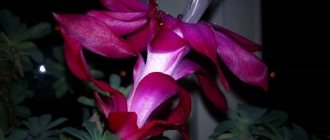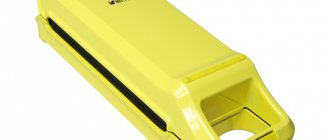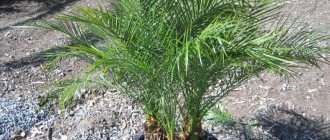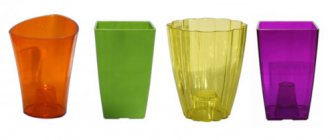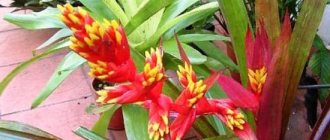In most cases, if you ask a person to describe a cactus, the result will be the same. A plump, gnarled little inhabitant of desert lands, covered with very sharp thorns. Few people go further than this definition. Someone might add that cacti bloom periodically and do not require frequent watering. This is where the baggage of botanical knowledge ends.
Therefore, many will be interested to know that the pretty plant, which we are all accustomed to calling “Decembrist”, is nothing more than a type of cactus. Its appearance can, of course, be misleading. Instead of the usual dense shoots, this flower develops long, jointed shoots. Common cactus spines of Schlumbergera (Schlumbergera)
does not have.
And you can’t call her a drought lover. The plant is also known to many under the names “ Rozhdestvennik
”, “
Decembrist
”, “
December
”, “
Christmas cactus
”.
By the way, this name was given to the flower by the collector A. Cunningham, who brought the plant from the forests of South America - not a very common place for cacti to grow, right?
Landing
Considering the location of the forests in which Schlumbergera traditionally grows, it is necessary to choose a sufficiently bright place for the flower where the sun's rays will be scattered. The pot should not be exposed to the full sun, since under natural conditions the shoots of this cactus cling to tree trunks, multiplying in their shade.
The roots of the plant are very short, so planting is carried out in a small container. For example, a plastic glass or a small pot. For beauty, you can choose a container with the same shade as the future flowers.
Location and lighting
In the apartment, the “Decembrist” will be comfortable on the windowsills of the western and eastern sides of the house. There is enough sun here to grow well and not so much that it dries out. Lighting should not be concentrated on the plant. Direct midday sun will cause irreparable damage. There is also no need to place a flower pot above radiators and heaters if you want to create a tropical climate. The ideal location for Schlumbergera in the warm season is on the veranda.
If the flower will live in the country, it must be protected from snails and slugs. A good solution would be to hang the pots in the shaded part of the garden.
Pot size
In its homeland, “Decembrist” begins to grow not in the soil near the trees, but on the trunks themselves and on the branches. Most likely, this is why the root system of the flower is poorly developed. The plant does not need to obtain nutrients by going deeper into the soil. Therefore, during initial planting, the size of the pot should not be large. 10 cm in height and 6 cm in diameter is enough.
The soil
The growth and development of any plant that is grown artificially depends on the conditions created. When the atmosphere is as close as possible to the natural habitat, flowers grow and bloom beautifully. The same thing happens with the “Decembrist”.
While the plant climbs tree trunks and branches, its roots have direct access to air. From this we can conclude that the soil should be as loose and breathable as possible.
To create such conditions, mixtures of peat, coarse sand and deciduous or turf soil are excellent. Classic mixture: 1 part earth and 1 part sand. Charcoal can serve as a pleasant addition to the standard composition.
But Schlumberger will not tolerate clay and loam - the substance is too dense and moisture-proof, in which access to air is severely limited.
Under the layer of soil in the pot you need to make drainage from crushed brick or small expanded clay. The drainage layer must conduct moisture well, since the Decembrist does not tolerate stagnant water
The acidity of the soil in the pot should be maintained at 5-6 PH.
Schlumbergera is a very unpretentious plant. It can develop in less nutritious soil, but then its flowering will be less pronounced or stop altogether.
Transfer
Before transplanting the plant, you need to prepare a new pot. Its dimensions are selected based on the dimensions of the previous container. The depth of the pot can remain the same. As with all plants of this species, the roots of Schlumbergera grow in the top layer of soil, without sinking too low. Therefore, the root system of the flower must be given the opportunity to grow in breadth and not in depth. It is necessary to select a new pot so that its diameter exceeds the previous one by 2-3 cm.
Transplantation occurs when the flowering period has passed. It is best to choose a day during the growing season. Flower growth occurs over the course of one month from late March to mid-April. If the plant is young, it is replanted annually, older flowers - once every two years.
The plant must be provided with rest after transplantation and good soil drainage. The root system of newly transplanted flowers is especially susceptible to rotting, so do not forget to add drainage litter.
Fertilizers and fertilizing
You need to feed the flower during flowering and growth, that is, no more than 2-3 times a year. Typically, fertilizers contain nitrogen, potassium and phosphorus. The optimal ratio is 9:24:18. You can use complex fertilizers, but you need to be careful to ensure that the nitrogen content is average. You cannot overdo it with this element, since its excess can cause active rotting of the root.
In general, Schlumbergera is considered a very unpretentious plant. For a long time it can grow and develop in very poor soil. But at the same time, the appearance of the plant will be unsightly.
During feeding, the flower should be in a well-lit room. Young shoots, stretching out in search of light, become brittle and faded. If the fertilizers and feeding time were chosen correctly, the “Decembrist” will grow magnificently.
Watering
Considering the climate native to Schlumbergera, the humidity of the soil and surrounding air must be maintained appropriately. In summer and during flowering, the plant is watered abundantly and evenly. The water should be warm and soft. The rest of the time, watering is reduced to a minimum. Once a week will be enough, you need to make sure that the soil does not dry out.
Soil for the Decembrist: how to prepare the soil yourself and what substrate to choose in the store?
On cold winter days, blooming Decembrists delight their owners with the bright lights of flowers. This is probably why zygocactus (Decembrist, Rozhdestvennik, Schlumbergera) is one of the most popular plants among gardeners, and also because of its ease of care.
However, few people know that Schlumbergera is quite demanding on the composition of the soil in which it grows. If a gardener approaches the issue of preparing the substrate irresponsibly, then the zygocactus is unlikely to please him with lush and long flowering.
What kind of soil is needed for the Decembrist? How to cook it? This article will try to answer these questions.
On what soils does Schlumbergera grow in nature?
Decembrist is an epiphytic cactus that grows in the tropical forests of South America. Its habitats are snags, stumps, tree trunks and places next to them. The zygocactus takes all the useful substances necessary for its full development from trees and nearby plants. Tropical soil is quite loose and light due to the constant rotting of leaves and grass.
What composition is recommended for home zygocacti?
The substrate for the Decembrist should be as natural as possible. It should be loose, light, easily permeable to water and air, nutritious, and well drained. Its components can be moss, rotted leaves, bark . The soil for the Decembrist should also have an acidic reaction (pH 5.5 -6).
There are many options for mixtures in which Decembrist can be planted, but a prerequisite is the presence of four components:
- Base : turf, garden, leaf soil.
- Baking powder : peat, coarse river sand, perlite, vermiculite, sphagnum moss, pieces of tree bark, fresh sawdust.
- Fertilizers : humus, turf, compost, vermicompost, mineral fertilizers (potassium-phosphorus).
- Drainage : expanded clay, gravel, pebbles, brick chips, crushed stone, foam chips, etc. The drainage layer is placed at the bottom of the container in which the plant is planted; it is allowed to add a small amount to the substrate.
What is better: making the substrate yourself or buying it in a store?
Both types of substrate are quite suitable for planting zygocactus. The only question is whether the gardener has extra money to purchase a substrate or enough free time necessary to prepare the soil mixture.
The advantages of purchased soil include, first of all, its complete readiness for use, while the substrate mixed by hand still needs to be treated thermally or with fungicides.
But when the mixture is prepared directly for a specific plant, you can choose a ratio of components that will completely satisfy all the needs of a particular flower. Experienced flower growers are of the opinion that it is still better to prepare the substrate at home .
What ready-made mixtures are suitable?
In a specialized store for planting Decembrist, sellers will offer a substrate intended for cacti or a universal one.
Despite the fact that the Christmas tree is a cactus, a substrate for succulents that is poor in nutrients is not suitable for it, unlike a universal one.
But still, soil for cacti has a number of characteristics that are important for the full development of Schlumbergera:
- looseness;
- air and moisture permeability;
- required level of acidity.
Therefore, professionals recommend mixing the above two types of purchased substrate in a 1:1 ratio .
When choosing a soil, you need to pay attention to the shelf life of the substrate, its composition, physical characteristics: normal level of humidity, fibrousness, the presence of loosening components.
For mature plants
- Prepare all the necessary components, which should be in different containers: 6 parts of leaf soil, 1 part of turf soil, 4 parts of humus soil, 2 parts of peat, 2 parts of sand, a little perlite or other baking powder (no more than 10% of the total volume).
- Prepare a large container in which all ingredients will be mixed.
- Prepare a measuring container, spatula, and gloves.
- Putting gloves on your hands, you should measure out the required volumes of all components of the substrate.
- After pouring all the ingredients into a large container, mix them thoroughly with a spatula.
- Pour the soil onto a baking sheet up to 5 cm thick and moisten it.
- The baking sheet should be placed in the oven, which is preheated to +70C - +90C. The duration of calcination is at least 30 minutes.
For a young Christmas boy
For young plants, the soil should be lighter and looser , so the percentage of raising agents should be higher than for adult plants with a strong root system.
- Prepare everything you need to prepare the mixture: a large container, a spatula, gloves, a measuring container.
- After drying all the ingredients, place them in different containers.
- Put gloves on your hands.
- Pour into a large container 2 parts of compost soil, 1 part of river sand, 2 parts of peat, 3% each of fresh sawdust, tree bark, perlite, vermiculite, sphagnum. Mix everything well.
- Pour the resulting substrate into a fine-mesh colander and pour in a fungicide solution or a bright pink solution of potassium permanganate.
What kind of pot does a Decembrist need?
When buying a pot for the Decembrist, you must be guided by the main criterion: it must be shallow, but wide . This requirement is caused by the fact that the root system of zygocactus is located in the upper layers of the soil.
When choosing a container, you should not chase voluminous and deep pots: as a rule, the plant begins to try to fill the available volume with its roots, and there is not enough strength for flowering.
If we talk about the material from which the pot should be made, then there are no restrictions.
Lovers of everything environmentally friendly tend to choose clay containers when choosing: the material is natural, no toxic substances are used in production, clay absorbs moisture well and allows air to pass through.
Today, specialized stores have a fairly wide range of plastic pots. This material allows you to maintain optimal temperature conditions, since it does not allow air to pass through at all.
But with any choice , it is better if the color of the container intended for the Decembrist is light : the soil poured into it will heat up less. Another important condition is that there must be drainage holes at the bottom of the pot to drain excess moisture.
When is it necessary to change the soil?
In order for Schlumbergera to actively grow, develop and delight with abundant flowering, it is periodically necessary to change the soil in which it grows. Young plants are usually replanted annually, adults - once every 3 years. Decembrist, which has reached a large size, is replanted once every 5 years.
Also, the soil must be changed immediately after purchasing a zygocactus at a flower shop. The substrate in which the plant is placed is intended for transporting the flower, but not for its permanent location. The soil is absolutely devoid of any nutrients, and a plant that remains in it for a long time is in danger of dying.
A Decembrist who suffers from infectious diseases should definitely change the substrate. Infection with fusarium, phytium, and late blight occurs most often through an infected substrate.
If signs of damage to the flower by fungal infections are detected, the zygocactus should be urgently transplanted into new soil, and the root system and the entire plant should be treated with special preparations.
Landing rules
- First of all, you need to pour a drainage layer on the bottom of the pot, the volume of which is equal to 1/3 of the total volume of the pot.
- Next, a layer of substrate is poured, the height of which should be at least 1 centimeter.
- The Decembrist, or rather its roots, are placed in the center of the container, which are carefully straightened and covered with soil.
- The top layer of soil is lightly pressed down to fix the plant.
The plant is not watered for 3-4 days , placed in a shaded place for 2 weeks.
After the adaptation period, care for the young Schlumbergera is carried out as usual.
Soil for the Decembrist plays an important role: a light, loose, nutritious substrate can ensure the full development of the plant.
Source: https://na-zemle.info/komnatnye-rasteniya/kaktusy-i-sukkulenty/shlyumbergera/uxod/pochva-dlya-dekabrista.html
Caring for the Decembrist at home
Caring for the Decembrist is simple, just remember its origin. Imagine a tropical forest: humidity, diffused light, no drafts, constant temperature all year round, nutritious soil and warm rains.
Create conditions close to tropical and your Decembrist will delight the eye with flowering not only in winter, but also in summer. Even if there is no need to force the Decembrist to bloom in warm weather, then for the sake of the health of the plant it is still recommended to create a semblance of the tropics at home.
Humidity can be provided by regular watering and spraying with warm, soft water. There is nothing complicated here: you need to water the Decembrist regularly , not allowing the earthen ball in the pot to dry out, and spray it daily, especially when the heating is on.
Diffused lighting can be created by placing it on an eastern or western window sill, or in the back of the room so that direct sunlight does not fall on the Decembrist stems. The scorching sun burns the leaves, and the plant begins to hurt, there is no time for flowering. Avoid placing a pot with Decembrist on a southern window sill. Decembrist stems turn yellow from sunburn, and the stem segments dry out and fall off.
Do not grow Decembrist in corridors and near windows that open to ventilate the room - drafts are guaranteed to undermine the health of Schlumbergera. Remember, the air around the Decembrist should stagnate.
Decembrist flowers fall off due to drafts and changes in place of residence. Photo: Chris Brenschmidt/Flickr
If there is a need to grow Decembrist on a balcony or loggia, then select a shady place for the plant, protected from the wind.
When the Decembrist forms buds and blooms, it is not recommended to rearrange or rotate the pot - the plant can throw off the buds and leave you without the “sweet”.
If there is a need for Decembrist to bloom repeatedly throughout the year, then after flowering the plant is moved to a cool place to rest. It is the alternation of periods of rest and flowering that guarantees repeated flowering of the Decembrist.
The tropical forest is warm all year round, which means that the comfortable temperature for the Schlumberger zygocactus is from +20°C to +25°C . This is the temperature in the phase of active growth and flowering, and for the dormant period a temperature of about +13-15°C is recommended.
Feed the Decembrist 2 times with complex fertilizer for flowers, making the concentration 2 times less than recommended. Zygocacti are very sensitive to large doses of fertilizers, so you should not overfeed Decembrist, especially during the dormant period.
Care after transplant
After transplanting a flower, it is necessary to organize conditions that are comfortable for it, which are close to those in its homeland:
- The air temperature for the Decembrist should be within 16-18 degrees in winter, and in summer he prefers temperature limits of 23-26 degrees Celsius.
- Humidity should be average. The flower will have nothing against spraying with warm water once a week in the summer.
- Direct sunlight in the summer may well destroy the plant; it prefers partial shade in the summer and walking in the fresh air.
Since in summer the flower grows its segments, it must be turned once a month in relation to the sun's rays so that the plant does not fall on its side towards the light source.
At the same time, twice a month Decembrist is fertilized with fertilizer intended for cacti.
Important! Dilute the fertilizer according to the instructions given on the package and water only on moist soil so as not to burn the root system of the flower.
Decembrist transplanting and pruning
From time to time, the Decembrist plant needs to be pruned and replanted into another pot, so it is worth knowing the features of pruning and replanting the plant. Usually the Decembrist is transplanted once into a pot of larger diameter (2 cm larger).
Decembrist is transplanted immediately after flowering, in February, into a wide, low pot, which provides drainage from pebbles or small crushed stone. There must be holes in the bottom of the pot.
The composition of the soil for Decembrist is as follows: peat, nutrient soil and sand, in a ratio of 2:1:1. In any case, the soil should be loose and nutritious.
Experienced cactus growers add crushed charcoal, vermiculite and coarse river sand to the Decembrist substrate to improve the air and moisture permeability of the soil.
Decembrist is pruned in June to give the plant an attractive appearance. Most often, regular anti-aging pruning is performed: ugly stems and stems growing crookedly are removed. To remove diseased stems, sanitary pruning can be done at any time of the year.
What ready-made mixtures are suitable?
In a specialized store for planting Decembrist, sellers will offer a substrate intended for cacti or a universal one. Despite the fact that the Christmas tree is a cactus, a substrate for succulents that is poor in nutrients is not suitable for it, unlike a universal one. But still, soil for cacti has a number of characteristics that are important for the full development of Schlumbergera:
- looseness;
- air and moisture permeability;
- required level of acidity.
Therefore, professionals recommend mixing the above two types of purchased substrate in a 1:1 ratio .
Diseases and pests of the Decembrist
The Decembrist plant is a perennial plant, therefore, during its life, the zygocactus can be attacked by pests and affected by diseases of various types, so the plant must be inspected regularly.
Most often, Decembrist is damaged by mealybugs, spider mites, scale insects and whiteflies. Having discovered pests, it is worth trying folk remedies: washing with soapy water, washing with vodka, etc., and only then using chemicals.
Like tomatoes and peppers, zygocacti are susceptible to late blight, fusarium and other fungal diseases. Most often, the cause of fungal diseases is waterlogging of the earthen clod and poor drainage. Fusarium usually affects the root collar of the Decembrist plant, the plant withers and becomes faded. Treatment of fungal diseases is carried out with fungicides, without waiting for the death of the plant.
How to care?
When growing Decembrist, you must follow a number of tips and recommendations from experts. Plant care consists of the following activities:
Basic rules of watering:
To feed the plant in spring and summer, you need to use mineral fertilizers with nitrogen and phosphorus.
In the fall, experts recommend adding microelements with potassium, and in the winter (during the flowering period) organic supplements will bring maximum benefit. will help increase the number of flowers .
In mid-summer, you can remove the shoots and form the desired crown shape. Experienced gardeners use pinched shoots to form new plants. Protecting a plant from diseases and pests is one of the main measures that will help to grow a beautiful and strong flower.
The most dangerous types of fungal diseases are fusarium and late blight. Signs of disease development are changes in the color of shoots and the death of segments. The main cause of fungal infection is the use of low-quality contaminated soil. Special fungicides will help cure these diseases. Ignoring this problem can lead to the death of the plant.
Various pests can also harm indoor flowers. Biologists identify several of the most dangerous types of insects:
To kill insects, it is necessary to treat the plant and soil with special chemicals.
Failure to follow plant care rules can cause the following problems:
For many decades, indoor plants have been an integral part of living spaces.
Green helpers not only serve as home decoration, but also purify the air and improve the health of the atmosphere.
Among the huge number of green favorites, florists recommend paying attention to the Decembrist, who will be able to please all family members during the New Year and Christmas holidays with bright and beautiful flowers.
Source
Decembrist does not bloom: reasons
Most often, Decembrist does not bloom due to improper growing conditions: little moisture, little light, cramped pot, poor soil, etc.
In any case, in order for the Decembrist to bloom, it is necessary to prepare it for flowering, ensuring peace in the fall, putting it in a cool room. At this time, the Decembrist is not watered or fed.
At the end of November, you need to move the zygocactus to a warm, bright place, start watering and feeding. After dormancy, the Decembrist quickly wakes up and forms buds.
When the Decembrist has formed buds and begins to bloom, it is necessary to provide illumination of the plant with an additional light source.
Rules for home care for a Decembrist
Following the simplest rules for caring for zygocacti will protect your plants from diseases and pests.
- During flowering, provide the zygocactus with good lighting and do not move the pot;
- During flowering, do not cut cuttings for propagation;
- Avoid temperature changes during flowering;
- In a cool room, Decembrist blooms longer;
- A narrow pot promotes abundant flowering;
- After dormancy, water and feed gradually to avoid shock;
- Decembrist flowers fall off due to a sharp change in conditions. There is no need to panic - the Decembrist will get used to the new conditions and bloom again.
Reasons for Decembrist leaves falling
The Decembrist sheds its leaves (stem petioles) when the conditions of detention are close to unbearable. Examine the plant carefully - perhaps pests drink the cell sap of the zygocactus like fleas. If no pests are observed, then the cause of leaf fall lies in a lack of nutrients in the soil or inappropriate growth factors: temperature, humidity, lighting, etc. replanting can also cause petioles to fall off.
What kind of drainage layer is needed under the soil?
The drainage layer is necessary to prevent acidification of the soil and rotting of roots, as it perfectly allows water to pass through and cleanses the soil of toxins and heavy metal salts.
Creating a soil drainage system affects the proper growth and health of the flower. This is especially true for the Decembrist, because he is prone to fungal and bacterial diseases. As drainage you can use:
These materials are sold in flower shops; they are completely safe and sterile, as they undergo special treatment against bacteria.
In addition, you can create a drainage system yourself. Suitable for this:
You can also use polystyrene foam . It should be crushed to crumbs. Foam chips protect the plant from hypothermia, but do not allow water to pass through well.
Another way to drain the soil is to add loosening additives, hydroabsorbent (vermiculite is added in a ratio of 1:10) and mineral additives (agoperlite).
For the Decembrist, you need to create a drainage layer that occupies one third of the pot. Before laying it, you need to thoroughly rinse and temper the materials used.
How to propagate Decembrist
The easiest way to propagate Decembrist is by propagation by green cuttings. Cuttings of zygocacti allow you to get a flowering plant for the next year. Zygocacti are propagated by seeds only by breeders.
Cuttings are taken from the tops of healthy stems. It is enough to cut off two leaves (green segments of the stem).
Green cuttings should be withered for two to three days and planted in containers filled with nutrient soil. You can root Decembrist cuttings in ordinary seedling boxes, under a lid.
How to plant Decembrist
This flower is quite easy to propagate. Even a novice gardener can do this. To do this, it is enough after flowering, when new growth of segments begins, to unscrew the cuttings with 2-3 adult segments clockwise and use them to propagate the plant. Also, such cuttings are formed after annual pruning, which is carried out after flowering.
There are two ways to germinate roots from cuttings:
- In water.
- In the ground.
Reproduction of Decembrist in water
The cuttings are unscrewed and placed in water to grow roots. In this case, only the lowest petiole is immersed in water, not forgetting to dry it for 3 hours after unscrewing. If the water becomes cloudy the next day, it is poured out and the cuttings are washed under running water.
After this, a tablet of activated carbon is added to the new water, and the cutting is placed again to build up the root mass.
Reproduction of the Decembrist in the ground
The cuttings are unscrewed and dried.
After this, take small containers filled with specialized soil. In the center, make a 2-3 cm depression with your finger or a pencil and plant the cuttings, deepening them by 1/3 of the segment.
If the room has good humidity and warmth, there is no need to cover the cuttings with anything. But if the room is very hot and dry, then it is worth covering such cuttings with a glass jar, but daily ventilation will be necessary. Because without them, a fungus can develop on the cutting from excess greenhouse humidity, which will lead to the death of the cutting.
What is it for?
Replanting is an essential element in the care of any plant, thanks to which the active growth of the bush and its abundant flowering are stimulated.
Decembrist transplant is required in 3 cases:
- The first transplant of a plant is carried out immediately after purchasing it at a flower shop.
Planned transplant. A young plant needs to be replanted annually, an adult - once every 3 years. If the Decembrist has reached too large a size, then it must be replanted once every 5 years.
The main purpose of this type of transplant is to change the soil or select a larger pot.
- If the plant is affected by diseases and pests. To eliminate some of them, urgent replacement of the soil is required.
What kind of soil is needed for the Decembrist? Types of pots used for planting indoor Schlumbergera
When engaged in floriculture, a gardener recreates the conditions for the most comfortable living of plants at home. One of the main points of care is preparing the soil. You can buy it in the store or prepare it according to your own recipe.
The soil performs the function of enriching the roots of flowers with nutrients and air. Each plant has its own type of soil. Some grow well in sandy soil, others prefer black soil, etc.
When is the best time to transplant Schlumbergera?
A favorable time for replanting a plant is the period after flowering - from the end of February to May inclusive. The fact is that in the spring, the Decembrist, like any plant, enters an active vegetative phase: new cells begin to form intensively due to the acceleration of metabolic processes occurring in it.
The trigger for the active growth of zygocactus is favorable weather conditions (increased daylight hours, increased temperature), which are very similar to their “native” ones.
Reference! It is not recommended to replant the plant in summer and autumn. Otherwise, the Christmas tree may not bloom or lose all its foliage.
Is it possible to disturb a plant during flowering?
Decembrist flowering time is from December to February. During this period, it is very vulnerable and reacts painfully to the slightest changes by dropping buds. The only exception in which flowers can be sacrificed is to save the zygocactus due to fungal infection or rotting roots.
Immediately after purchase
Replanting after purchase must be done , since the plant is sold in low-nutrient transport soil. If the zygocactus is left in the same container, it will soon disappear.
What is better: making the substrate yourself or buying it in a store?
Both types of substrate are quite suitable for planting zygocactus. The only question is whether the gardener has extra money to purchase a substrate or enough free time necessary to prepare the soil mixture.
The advantages of purchased soil include, first of all, its complete readiness for use, while the substrate mixed by hand still needs to be treated thermally or with fungicides.
But when the mixture is prepared directly for a specific plant, you can choose a ratio of components that will completely satisfy all the needs of a particular flower. Experienced flower growers are of the opinion that it is still better to prepare the substrate at home .
What kind of pot does a zygocactus need?
The root system of the Decembrist is superficial, that is, it grows in breadth and not in depth.
The Christmas pot is not deep, but wide. However, a container that is too large is also not the best option, since the plant will strive to fill the entire container with roots, devoting all its energy to growing them. In this case, you can forget about Schlumbergera flowering. The size of the pot should be slightly larger than the previous one (10%).
As for the material from which the pot is made, both plastic and clay containers are equally suitable. Plastic is a substance that does not absorb water and does not change the temperature of the soil in the pot. Clay and ceramics are environmentally friendly products. The choice in this matter remains with the florist. But it is better if the pot is light in color so that the soil in it heats up less.
Important! A prerequisite for the pot: it must have drainage holes at the bottom, designed to drain excess moisture.
How to plant a Decembrist shoot
Before planting the shoot, you need to carry out some manipulations:
- Option one. You can place the cuttings in a container with water, preferably warm. The shoot should not be all in water, but half. After a week, maximum 2, the first roots will begin to form, now the shoot is ready for transplanting into solid soil.
- Option two. To begin with, the cuttings are kept in water for three days and then planted in a special substrate. This will help the shoot take root. The top of the cutting is covered with a jar; it can be replaced with a bag or a special bag. Every day the jar should be raised for a couple of hours to ventilate. When the Decembrist releases the roots, the polyethylene or jar is removed. New stems will help you understand that the root system has formed.
Now the plant is ready to be transplanted into a flowerpot. Everything is done in accordance with the instructions for adult Decembrists. You can place several shoots in one pot at the same time.
Let's watch a video about transplanting shoots and propagating Decembrist:
How to choose the right soil?
Ordinary garden soil is not suitable for rooting and growing Schlumbergera . A special substrate for cacti can be purchased at a specialized flower shop. Its main components will be river sand, humus from leaves and turf, peat and all the necessary nutrients.
If it is not possible to purchase this mixture, then you can prepare it yourself: coarse river sand, garden soil, peat, combine in a ratio of 1:1:0.5. You can add some crushed dry leaves and foam balls, brick chips or vermiculite. Another option: turf soil, sand, peat, leaf soil in the ratio 1:1:1:2, respectively.
Don’t forget about the essential component of the internal filling of the pot – drainage. Drainage is a layer of certain materials that helps drain excess water during irrigation. As a drainage layer, you can use expanded clay, pebbles, small stones, broken brick or brick chips, broken polystyrene foam, and pre-cut wine corks.
What soil to replant in?
The soil can be purchased ready-made labeled “For cacti.” If you don’t have it, you can make it yourself by taking all the ingredients in equal proportions:
- Leaf soil - collected under trees in the forest away from roads;
- Turf land;
- Sand;
- ¼ part of humus.
You can also add a little soil “For Orchids” to this composed soil, which contains coal and bark. The soil should be nutritious and loose. And as it settles in the pot, it is added to the required level.
Soil made on your own requires sterilization. To do this, it is steamed for 20 minutes in the oven at 200 degrees. Or you can put it in the freezer of the refrigerator for a day.
Important! The soil must be loose, as this is an epiphytic plant.
Instructions for replanting a flower at home
- Prepare everything you need: Decembrist in an old pot, a new container, drainage, a knife, activated carbon, alcohol.
- At the bottom of the container, in order to prevent root rotting, it is necessary to pour a drainage layer, the volume of which will be equal to 1/3 of the entire pot.
- The top of the drainage should be covered with a layer of soil, the height of which depends on the volume of the plant’s root system, but not less than 1 cm. Level.
How to transplant an adult Decembrist
For an adult Decembrist, the transshipment method is used.
You must act in accordance with the following instructions:
- Take a dry and clean pot, a couple of centimeters larger than the previous one.
- Disinfected, fresh soil is prepared.
- A new drainage is made. Expanded clay can be used from under other plants, but before use it must be processed, washed and dried.
- A third of the container is covered with a drainage layer. To ensure that it lies evenly, you need to shake the pot slightly and tap on it.
- Specialized soil, one centimeter thick, is poured out and leveled.
- You need to lay out newspaper or film on the floor. Take a Decembrist plant with a flowerpot and gently fluff up the soil around the edges without touching the root system.
- Holding the trunk, turn the flower over onto the floor and slowly remove it from the container.
- Shake off the soil from the roots, but only the soil that can be removed without effort.
- If the roots were not damaged, then the roots, along with the soil, are lowered into a new pot.
The plant is filled with substrate until all the roots are covered. To avoid emptiness, you need to tap the pot during this process. It is also important that the stem stands straight.
The soil is carefully compacted. If this work is done roughly, the root system can be damaged.
The soil is watered abundantly; if necessary, more soil is added, but the soil should not be filled to the edges of the pot.
Let's watch a video on how to transplant Decembrist at home:
Possible difficulties
Preparing for landing
Decembrist is grown both in ordinary pots and in hanging ones, as hanging plant species. Schlumbergera's natural habitat is tropical rainforests, so it is important to provide it with a suitable microclimate.
Optimal conditions and choice of location
Southern and southwestern window sills are not suitable for zygocactus; direct sunlight is contraindicated for it. During periods of high sun activity, it is recommended to shade the flowerpot, otherwise its foliage will begin to turn yellow and the buds may fall off.
The optimal comfortable temperature for growing a plant is +18°C–+25°C. In summer, you can take the flower out into the fresh air, to a place protected from drafts.
Pot material and size
It is important to correctly determine what size pot the plant needs. Decembrist has a shallow root system, so a container that is too deep is not suitable. Moisture will accumulate at its bottom, which the short roots will not be able to absorb. This will lead to waterlogging of the soil and, ultimately, to rotting of the roots.
The Christmas pot can be plastic or clay.
Both materials are suitable, but growing in them has its own nuances:
- in a plastic pot, a good layer of drainage is required, since the material is not porous, excess moisture will not evaporate, but accumulate in the soil;
- unglazed clay conducts heat well; thanks to numerous pores, it evaporates moisture and allows oxygen to pass through. Disadvantage - over time, stains from salt deposits appear on the walls;
- Glazed clay has good thermal conductivity, but the glaze partially closes the pores.
Preparing the soil for planting
The soil for the Decembrist must be fertile and porous.
To independently prepare the soil mixture, take the following components (the proportion is: 2:1:1:1):
- turf land;
- leaf humus;
- peat;
- coarse sand.
For better throughput, fine gravel or vermiculite is added to the soil. River sand should be thoroughly washed before use. The prepared mixture for prevention is calcined in the oven for half an hour at t + 90°C.
How to plant Decembrist at home
You can grow Christmas trees vegetatively (cuttings, grafting) or seeds.
Cuttings
The preparation of cuttings is combined with the pruning procedure. You can plant one segment or a shoot with 2-4 segments. It is best to take cuttings for planting with aerial roots, which the plant forms during the growth process.
Germination is performed using two methods:
- In water.
- In the ground.
Features of growing plants in water:
- the shoot is “unscrewed” by hand from the main stem and left to dry for several hours;
- pour water into a small container, which should cover the upper part of the cutting;
- the water is changed periodically;
- When roots appear, the cuttings are transplanted into the ground.
- When grown from one segment or leaf, several specimens are planted in the ground at once in a circle.
Another method is faster, since the shoots are planted directly into the ground:
- The selected cuttings are treated with the growth stimulator "Kornevin".
- The soil in the pot is not compacted.
- If there are no roots, plant them in the ground, completely deepening one segment. If there are aerial roots, the cuttings are buried 1–1.5 cm.
In order for the plant to take root, the pots are covered, for example, with a glass jar, which serves as a kind of greenhouse. The seedlings are placed in a warm place with a temperature of +16°C–+20°C, in partial shade. Water moderately, not allowing the soil to dry out. Ventilate daily, removing the cover for half an hour.
Graft
This manipulation is carried out mainly by professional flower growers to improve the characteristics of the plant. A cactus plant (prickly pear or perescia) is also taken as a rootstock. The scion is a cutting of 2–3 segments.
The grafting technology is as follows:
- The leaf mass is removed from the top of the rootstock.
- Using a sharp knife, make an incision into which the cutting is placed.
- The grafting site is tightly wrapped with thick thread.
- Place the plant in an area with diffused lighting at a temperature not lower than +18°C.
- When new segments of the Decembrist appear, the thread is removed.
Aftercare
Schlumbergera, who has experienced the stress of a transplant, will need special attention. First of all, it must be placed in a cool and shaded place for two weeks. Decembrist should not be watered for 3-4 days , but only irrigated with a spray bottle. This is necessary so that the plant has time to “heal” all the roots injured during transplantation.
Attention! The first watering should be moderate and carried out with warm water.
It is not worth feeding for a month or two, thereby providing the plant with the rest necessary for adaptation. If the plant takes root successfully, then you need to pinch each shoot: this step stimulates the formation of new branches, and flowering will be more abundant and longer.
Transplanting a zygocactus is a simple process; it will not cause any particular difficulties even for an inexperienced gardener. With a little effort, you will be generously rewarded with abundant and vibrant flowering of your favorite Decembrist.
Decembrist: planting methods and care
Most indoor plants delight their owners with beautiful, bright and fragrant flowers in spring and summer, when their colors merge with the greenery of nature. During winter frosts, most plants slow down their growth and go into a dormant state. One of the most popular house flowers, Decembrist, will surprise you with its abundant flowering before the New Year holidays. Florists recommend that you definitely purchase this plant, carefully study its features and care rules, then your New Year’s decoration will be not only a Christmas tree, but also a luxurious flower.
We transplant the Decembrist into another pot
If you do not plan to replant the cactus, you can partially renew the soil in the old pot. To do this, remove 3-6 cm of bad soil and add fresh soil. Thus, Schlumbergera will receive a powerful incentive for growth and high-quality flowering.
An old container can come in handy if you are replanting an overgrown bush. Thanks to this, the cactus will rejuvenate. The pot should be cleaned, scalded with boiling water, dried, and then reused.
You should select a new flowerpot not only for aesthetic reasons. Here the shape, dimensions, and material become important. The size is determined simply by ensuring that the old one fits freely into the new one.
It was larger by about 3 cm in diameter. The shape is wide but shallow. The peculiarity of zygocactus is that the surface roots do not reach the bottom. Therefore, he is not a fan of large flowerpots.
The tighter the pot, the more active the growth and flowering processes. In addition, water will not collect at the bottom, preventing waterlogging of the soil. Pots must have a drainage hole.
Vases can be from:
- ceramics. Natural material with a huge selection of colors and sizes makes it possible to find the design you like;
- clay. Eco-friendly raw materials with a porous structure that quickly removes excess moisture;
- glass Transparent, allowing you to monitor the development and health of the roots;
- plastic. Lightweight, breathable, relatively inexpensive.


